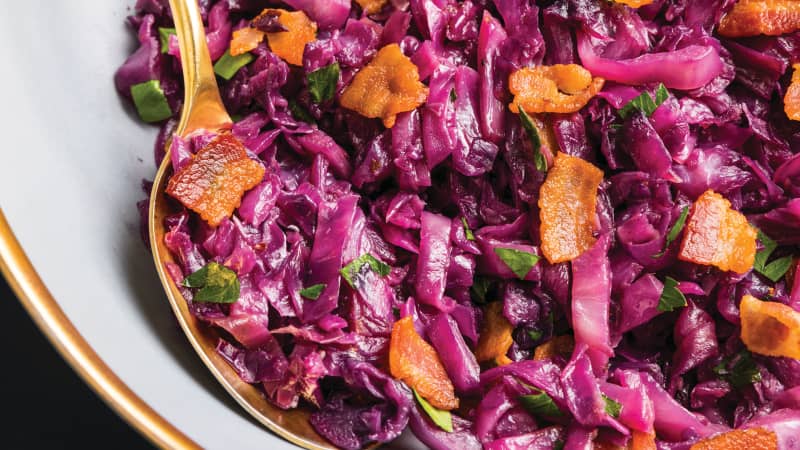Red cabbage is inexpensive, long storing, widely available, and strikingly beautiful. Because it takes longer to mature than other varieties, it’s also impressively sturdy. For that reason, a quick sauté can leave it unappealingly tough, so I prefer a tenderizing braise. The cabbage not only turns silky but also melts into a uniform and vivid bright purple, making it a cheerful dish to enjoy in late fall and winter, when food tends toward the brown and beige sections of the color wheel.
How to Raise Your Red-Cabbage Braising Game
Published Sept. 29, 2020.

As I cast my mind back over the many braised red cabbage recipes I’d eaten and made, a theme emerged: The dish always has a sweet-and-sour profile. Research revealed that this isn’t a coincidence. Red cabbage gets its color from pH-sensitive compounds called anthocyanins, and if the cooking liquid skews even a little alkaline (tap water rarely comes in at a perfect 7 on the pH scale), the cabbage can turn an unappetizing blue color. A little acid in the form of wine, vinegar, or citrus juice keeps things rosy, and then some sugar balances it out.
How to Slice Cabbage

1. Quarter cabbage through base; cut core out of each quarter.

2. Separate each quarter into thin stacks; slice stacks crosswise into thin strips.
My usual cooking method is to fry some chopped bacon, reserve it as a garnish, and then sauté some alliums (often shallots) in the leftover fat. Then I add the thinly sliced cabbage and water or stock with a shot of acidic liquid (typically vinegar). It’s a simple way to do things, but I find that it generally takes more than an hour for the cabbage to fully soften.
Years ago, I learned that adding some acid to the cooking water can keep vegetables firm by strengthening the pectin in their cell walls. It’s a handy trick if you’re boiling potatoes for a salad, but now it occurred to me that adding the color-preserving vinegar to my cabbage at the outset was probably slowing the cooking.

I tried braising the cabbage in plain water without any vinegar, and sure enough it took just 30 minutes to soften. But now, unsurprisingly, the cabbage was blue. Would adding vinegar at this point correct the color? I poured a glug of red wine vinegar into the pot to find out, and happily, the bright-purple color returned instantly.
The bacon and shallots provided plenty of savory backbone, and the sugar and vinegar supplied the right sweet-and-sour profile, but the cabbage cried out for a couple finishing touches. A freshly grated apple added toward the end of cooking contributed freshness, and a generous spoonful of Dijon mustard gave the dish a subtle but pervasive piquancy. A handful of bright-green chopped parsley accented the deep purple of the cabbage nicely. And that’s how I raised my braising game.

